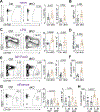H3K27me3 Demethylase UTX Restrains Plasma Cell Formation
- PMID: 35346967
- PMCID: PMC9012698
- DOI: 10.4049/jimmunol.2100948
H3K27me3 Demethylase UTX Restrains Plasma Cell Formation
Abstract
B cell differentiation is associated with substantial transcriptional, metabolic, and epigenetic remodeling, including redistribution of histone 3 lysine 27 trimethylation (H3K27me3), which is associated with a repressive chromatin state and gene silencing. Although the role of the methyltransferase EZH2 (Enhancer of zeste homolog 2) in B cell fate decisions has been well established, it is not known whether H3K27me3 demethylation is equally important. In this study, we showed that simultaneous genetic deletion of the two H3K27 demethylases UTX and JMJD3 (double-knockout [Utx fl/fl Jmjd3 fl/fl Cd19 cre/+] [dKO]) led to a significant increase in plasma cell (PC) formation after stimulation with the T cell-independent Ags LPS and NP-Ficoll. This phenotype occurred in a UTX-dependent manner as UTX single-knockout mice, but not JMJD3 single-knockout mice, mimicked the dKO. Although UTX- and JMJD3-deficient marginal zone B cells showed increased proliferation, dKO follicular B cells also showed increased PC formation. PCs from dKO mice upregulated genes associated with oxidative phosphorylation and exhibited increased spare respiratory capacity. Mechanistically, deletion of Utx and Jmjd3 resulted in higher levels of H3K27me3 at proapoptotic genes and resulted in reduced apoptosis of dKO PCs in vivo. Furthermore, UTX regulated chromatin accessibility at regions containing ETS and IFN regulatory factor (IRF) transcription factor family motifs, including motifs of known repressors of PC fate. Taken together, these data demonstrate that the H3K27me3 demethylases restrain B cell differentiation.
Copyright © 2022 by The American Association of Immunologists, Inc.
Figures







References
-
- Fairfax KA, Kallies A, Nutt SL, and Tarlinton DM. 2008. Plasma cell development: from B-cell subsets to long-term survival niches. Semin Immunol 20: 49–58. - PubMed
-
- Amanna IJ, Carlson NE, and Slifka MK. 2007. Duration of humoral immunity to common viral and vaccine antigens. N Engl J Med 357: 1903–1915. - PubMed
-
- Pillai S, and Cariappa A. 2009. The follicular versus marginal zone B lymphocyte cell fate decision. Nat Rev Immunol 9: 767–777. - PubMed
-
- Nutt SL, Hodgkin PD, Tarlinton DM, and Corcoran LM. 2015. The generation of antibody-secreting plasma cells. Nat Rev Immunol 15: 160–171. - PubMed
MeSH terms
Substances
Grants and funding
LinkOut - more resources
Full Text Sources
Molecular Biology Databases
Research Materials
Miscellaneous

